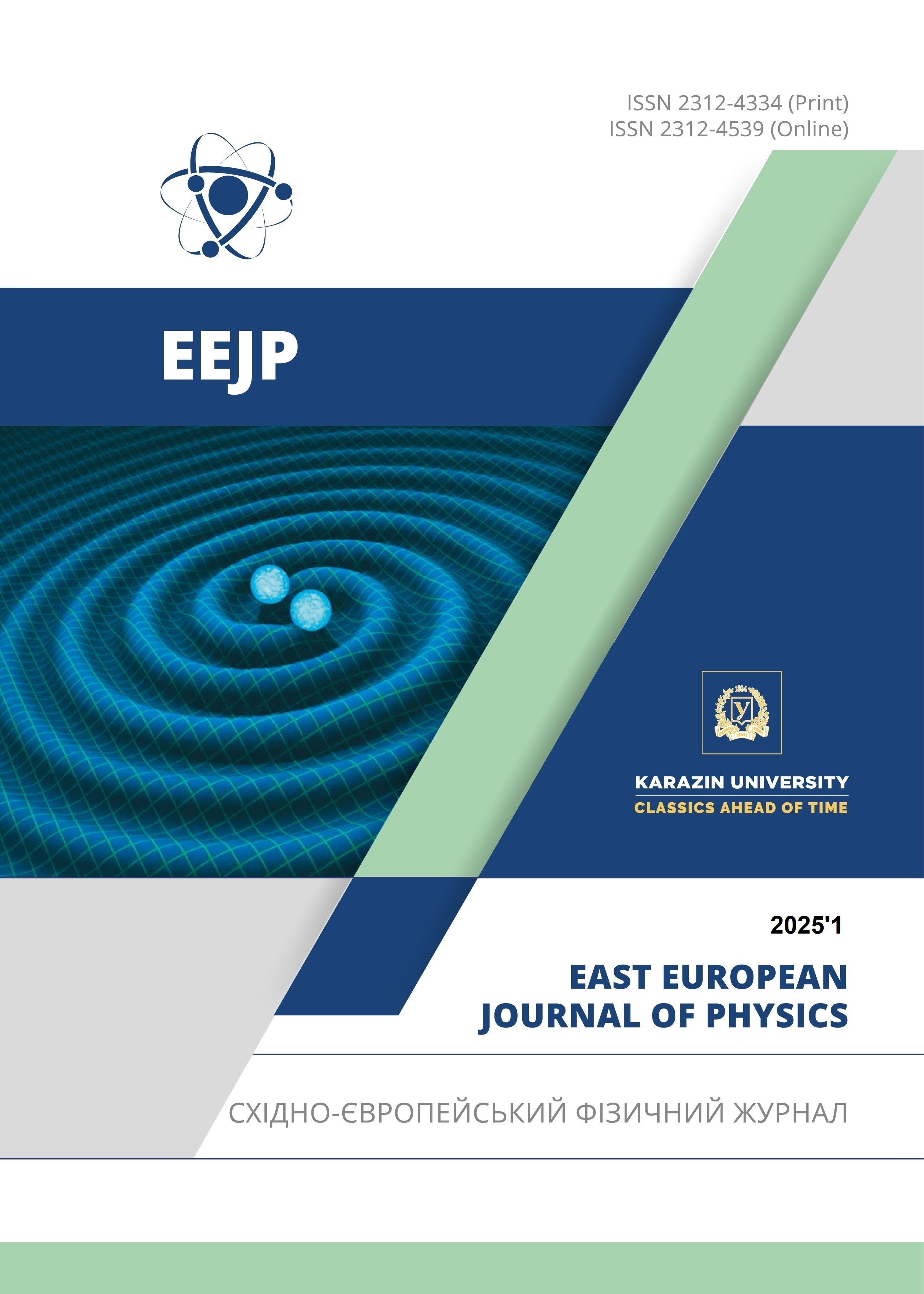Performance Enhancement of InGaP/GaAs Dual-Junction Solar Cells Through BSF Layer Optimization and Hetero-Tunnel Junction
Abstract
This study focuses on the simulation and optimization of an InGaP/GaAs dual-junction solar cells using Silvaco Atlas software, with a special emphasis on the incorporation of a hetero tunnel junction. The hetero-tunnel junction plays a pivotal role in enabling efficient charge carrier transport between the sub-cells, significantly improving the overall cell efficiency. Additionally, a new back-surface field (BSF) layer was integrated into the GaAs bottom sub-cell to further enhance performance. Various material combinations for the hetero-tunnel junction such as GaInP/GaAs, AlGaInP/GaInP, and AlGaInP/GaAs were systematically tested to assess their influence on device efficiency. The optimized structure demonstrated a short-circuit current density of 1.780 mA/cm², an open-circuit voltage of 2.310 V, a fill factor of 86.501%, and a conversion efficiency of 35.57% under AM1.5G illumination at 300 K. Recombination losses were minimized by the BSF layer optimization in the top and bottom cell, particularly with AlGaInP, leading to improved charge collection. Elevated temperatures were found to reduce both the open-circuit voltage and efficiency, highlighting the necessity of thermal management. These optimizations represent significant improvements over prior designs.
Downloads
References
N. Akter, M.A. Matin, and N. Amin, “High performance InxGa1-xN Tandem solar cells designed from numerical analysis,” in: CEAT 2013 - 2013 IEEE Conf. Clean Energy Technol, 2013, pp. 469–472. https://doi.org/10.1109/CEAT.2013.6775678
J.B. Garcia, Indium Gallium Nitride Multijunction Solar Cell Simulation Using Silvaco Atlas, Security, 110, (2007)
C. Cornet, M. Da Silva, C. Levallois, and O. Durand, “GaP/Si-based photovoltaic devices grown by molecular beam epitaxy,” in: Molecular Beam Epitaxy, second edition), (2018), pp. 637–648. https://doi.org/10.1016/B978-0-12-812136-8.00030-X
L. Hafaifa, M. Maache, and M.W. Bouabdelli, “Improving the Performance of CZTS/CZTSSe Tandem Thin Film Solar Cell,” J. Nano- Electron. Phys. 16, 1–6 (2024). https://doi.org/10.21272/jnep.16(2).02018
E. Raza, and Z. Ahmad, “Review on two-terminal and four-terminal crystalline-silicon/perovskite tandem solar cells; progress, challenges, and future perspectives,” Energy Reports, 8, 5820–5851 (2022). https://doi.org/10.1016/j.egyr.2022.04.028
L. Hafaifa, M. Maache, and Y. Djalab, “Performance Enhancement of CGS/CIGS Thin Flm Tandem Solar Cell Using Different Buffer Layers,” J. Opt. (2024). https://doi.org/10.1007/s12596-024-02035-1
A. Ghadimi, and H. Arzbin, “Efficiency improvement of ARC less InGaP/GaAs DJ solar cell with InGaP tunnel junction and optimized two BSF layer in top and bottom cells,” Optik, 148, 358–367 (2017). https://doi.org/10.1016/j.ijleo.2017.09.016
F. Djaafar, B. Hadri, and G. Bachir, “Optimal parameters for performant heterojunction InGaP/GaAs solar cell,” Int. J. Hydrogen Energy, 42, 8644–8649 (2017). https://doi.org/10.1016/j.ijhydene.2016.06.139
F. Djaafar, B. Hadri, and G. Bachir, “IV Characteristics of InGaP/GaAs Solar Cell with the presence of a Back Surface Field and a Tunnel junction,” J. Electr. Syst. 14, 64–76 (2018).
B. Zhao, X.-S. Tang, W.-X. Huo, Y. Jiang, Z.-G. Ma, L. Wang, W.-X. Wang, et al., “Characteristics of InGaP/GaAs double junction thin film solar cells on a flexible metallic substrate,” Sol. Energy, 174, 703–708 (2018). https://doi.org/10.1016/j.solener.2018.06.099
T. Sogabe, Y. Shoji, N. Miyashita, D.J. Farrell, K. Shiba, H.-F. Hong, and Y. Okada, “High-efficiency InAs/GaAs quantum dot intermediate band solar cell achieved through current constraint engineering,” Next Mater. 1, 100013 (2023). https://doi.org/10.1016/j.nxmate.2023.100013
F.Z. Kharchich, and A. Khamlichi, “Optimizing efficiency of InGaP/GaAs dual-junction solar cells with double tunnel junction and bottom back surface field layers,” Optik, 272, 170196 (2023). https://doi.org/10.1016/j.ijleo.2022.170196
L. Hafaifa, M. Maache, Z. Allam, and A. Zebeir, “Simulation and performance analysis of CdTe thin film solar cell using different Cd-free zinc chalcogenide-based buffer layers,” Results Opt. 14, 100596 (2024). https://doi.org/10.1016/j.rio.2023.100596
J.L. Gray, Handbook of Photovoltaic Science and Engineering, Chapter 3, (John Wiley & Sons, Ltd, 2003), pp. 61–112.
M.H. Tsutagawa, and S. Michael, “Triple junction InGaP/GaAS/Ge solar cell optimization: the design parameters for a 36.2% efficient space cell using Silvaco ATLAS modeling & simulation,” in: 2009 34th IEEE Photovolt. Spec. Conf. IEEE, (2009), pp. 1954–1957. https://doi.org/10.1109/PVSC.2009.5411544
J.E. VanDyke, “Modeling laser effects on multi-junction solar cells using Silvaco ATLAS software for spacecraft power beaming applications, PhD Thesis. Monterey, California. Naval Postgraduate School, 2010.
J.B. Lavery, “Quantum tunneling model of a pn junction in Silvaco,” PhD Thesis. Monterey, California. Naval Postgraduate School, (2008).
L. Hafaifa, M. Maache, and M.W. Bouabdelli, “Improved performance of CdTe thin-film solar cell through key parameters,” J. Theor. Appl. Phys. 18, 1–10 (2024). https://doi.org/10.57647/j.jtap.2024.1803.35
R.R. King, N.H. Karam, J.H. Ermer, N. Haddad, P. Colter, T. Isshiki, H. Yoon, et al., “Next-generation, high-efficiency III-V multijunction solar cells,” in: Conf. Rec. Twenty-Eighth IEEE Photovolt. Spec. Conf. (Cat. No. 00CH37036), IEEE, 2000, pp. 998–1001. https://doi.org/10.1109/PVSC.2000.916054
K.J. Singh, and S.K. Sarkar, “Highly efficient ARC less InGaP/GaAs DJ solar cell numerical modeling using optimized InAlGaP BSF layers,” Opt. Quantum Electron. 43, 1–21 (2012). https://doi.org/10.1007/s11082-011-9499-y
Atlas User’s Manual, SILVACO Inc, Santa Clara, CA 95054, California, USA, 2018.
I. Vurgaftman, J.A.R. Meyer, and L.R. Ram-Mohan, “Band parameters for III–V compound semiconductors and their alloys,” J. Appl. Phys. 89, 5815–5875 (2001). https://doi.org/10.1063/1.1368156
S. Abbasian, and R. Sabbaghi-Nadooshan, “Design and evaluation of ARC less InGaP/AlGaInP DJ solar cell,” Optik, 136, 487–496 (2017). https://doi.org/10.1016/j.ijleo.2017.02.078
G.S. Sahoo, and G.P. Mishra, “Effective use of spectrum by an ARC less dual junction solar cell to achieve higher efficiency: a simulation study,” Superlattices Microstruct. 109, 794–804 v. https://doi.org/10.1016/j.spmi.2017.06.002
G.S. Sahoo, P.P. Nayak, and G.P. Mishra, “An ARC less InGaP/GaAs DJ solar cell with hetero tunnel junction,” Superlattices Microstruct. 95, 115–127 (2016). https://doi.org/10.1016/j.spmi.2016.04.045
S.M. Sze, Y. Li, and K.K. Ng, Physics of semiconductor devices, (John wiley & sons, 2021).
M. Verma, and G.P. Mishra, “An integrated GaInP/Si dual-junction solar cell with enhanced efficiency using TOPCon technology,” Appl. Phys. A Mater. Sci. Process. 126, 1–13 (2020). https://doi.org/10.1007/s00339-020-03840-8
S. Bagheri, R. Talebzadeh, B. Sardari, and F. Mehdizadeh, “Design and simulation of a high efficiency InGaP/GaAs multi junction solar cell with AlGaAs tunnel junction,” Optik, 199, 163315 (2019). https://doi.org/10.1016/j.ijleo.2019.163315
H.R. Arzbin, and A. Ghadimi, “Improving the performance of a multi-junction solar cell by optimizing BSF, base and emitter layers,” Mater. Sci. Eng. B, 243, 108–114 (2019). https://doi.org/10.1016/j.mseb.2019.04.001
Y.P. Varshni, “Temperature dependence of the energy gap in semiconductors,” Physica, 34, 149–154 (1967). https://doi.org/10.1016/0031-8914(67)90062-6
H.M. Ali, M. Mahmood, M.A. Bashir, M. Ali, and A.M. Siddiqui, “Outdoor testing of photovoltaic modules during summer in Taxila, Pakistan,” Therm. Sci. 20, 165–173 (2016). https://doi.org/10.2298/TSCI131216025A
L. Hafaifa, M. Maache, S. Rabhi, Z. Allam, Z.I. Gouchida, Y. Benbouzid, A. Zebeir, and R. Adjouz, “Enhanced CZTSSe Thin-Film Solar Cell Efficiency: Key Parameter Analysis,” Phys. Status Solidi Appl. Mater. Sci. 222(2), 2400332 1–8 (2024). https://doi.org/10.1002/pssa.202400332
E.T. Mohamed, A.O.M. Maka, M. Mehmood, Al.M. Direedar, and N. Amin, “Performance simulation of single and dual-junction GaInP/GaAs tandem solar cells using AMPS-1D,” Sustain. Energy Technol. Assessments, 44, 101067 (2021). https://doi.org/10.1016/j.seta.2021.101067
Copyright (c) 2025 Ikram Zidani, Zouaoui Bensaad, Loumafak Hafaifa, Hamza Abid, Ahmed Hafaifa

This work is licensed under a Creative Commons Attribution 4.0 International License.
Authors who publish with this journal agree to the following terms:
- Authors retain copyright and grant the journal right of first publication with the work simultaneously licensed under a Creative Commons Attribution License that allows others to share the work with an acknowledgment of the work's authorship and initial publication in this journal.
- Authors are able to enter into separate, additional contractual arrangements for the non-exclusive distribution of the journal's published version of the work (e.g., post it to an institutional repository or publish it in a book), with an acknowledgment of its initial publication in this journal.
- Authors are permitted and encouraged to post their work online (e.g., in institutional repositories or on their website) prior to and during the submission process, as it can lead to productive exchanges, as well as earlier and greater citation of published work (See The Effect of Open Access).








